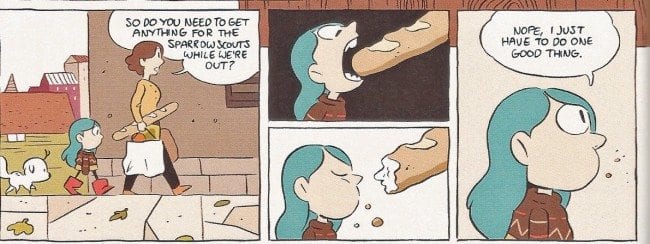 The term "all ages" gets thrown around like tennis balls at the U.S. Open these days, with a multitude of publishers and cartoonists expressing a desire to produce comics that appeal to both children and adults alike.
The term "all ages" gets thrown around like tennis balls at the U.S. Open these days, with a multitude of publishers and cartoonists expressing a desire to produce comics that appeal to both children and adults alike.
That's a very wide gap to cross however, and few comics that proclaim to be for "all ages" are actually able to actively engage and delight both young and old discerning minds.
Enter Luke Pearson. Though he hasn't been professionally making comics for very long (since 2010 if I'm reading his website correctly), he's already amassed an impressive body of work, and has something of a runaway hit on his hands with the genuinely charming, smartly realized, and lovingly delineated Hilda series, published by Nobrow. Here is a collection of comics that reward your attention, regardless of your age bracket.
The latest book in the series, Hilda and the Black Hound, arrived in stories earlier this year and finds the spirited young heroine attempting to aid a homeless gnome of sorts, while investigating the whereabouts of a mysterious and potentially deadly dog and attempting to try her hand at scouting. While fully ensconced in the "plucky child gets to the bottom of things" genre that's so prevalent in children's literature, Pearson's ability to carefully blend the fantastic with the every day, along with his freewheeling imagination, nimble line and rich use of colors, that make these volumes pop out.
I talked to Pearson over the Internet about his career and the new book. It took way longer than it should have, mainly due to my own incompetence and inertia, so I'd like to take this moment to thank him for both his time and patience.
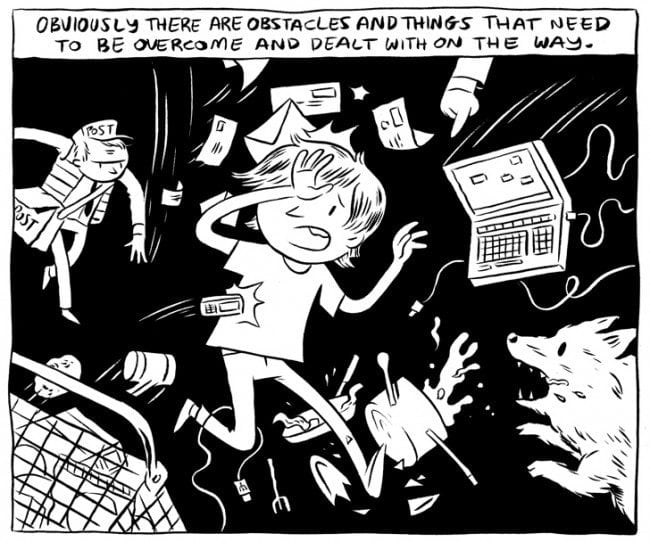
Let’s start with the basic biographical information. When were you born and where are you from?
I was born in Stockton on Tees in 1987, but I mainly grew up in Tamworth, a town just north east of Birmingham. I currently live in Nottingham.
What was Tamworth like when you were growing up? How would you describe it?
I think when you're growing up, where you live is just where you live, so it seemed perfectly fine, if unremarkable. It certainly wasn't terrible, but it isn't a place that was ever going to tempt me to stick around forever. It's got a castle but there aren't any bookshops.
What did/do your parents do for a living? Are they artistically inclined?
They are artistically inclined, but they haven't made their living that way. My dad works in IT and software development, but he plays and records music in his spare time. My mum used to work as a solicitor's secretary but she's drawn and painted for as long as I can remember and recently began selling artwork, greeting cards and the like online.
I’m assuming you drew a lot as a child or had an interest in art? Did your parents encourage that at all? Did you grow up wanting to have a career in art or illustration?
Yeah I was drawing all the time, in much the same way as anyone who ends up doing this was. It was definitely encouraged, though not in any kind of overbearing way. If I stopped drawing at any point I don't think anyone would have said anything, but I always got a lot of praise and excitable responses when I showed things to my family and that spurred me on. Whenever I visited my grandparents house for the holidays I would draw a new episode of this ongoing Super Rabbit comic for them to read. Most of the time a good response would be someone telling me I could be a famous artist one day or "hold onto these, they'll be worth something one day", and as a kid I think I kind of half believed that. But my Grandma would respond with the kind of enthusiasm of a fan and would always seem to be genuinely excited and impatient to know what happened next. I think the feeling I got from being able to deliver that and seeing how she reacted to it is the same feeling I get now when I'm drawing a comic.
I definitely always wanted to do something involving drawing but it took a long time to figure out what you could even do. I just always wanted to make stuff up. I remember wanting to be a concept artist, even though I've never drawn anything close to anything any concept artist has ever drawn. I used to draw fake catalog pages of books and video games that don't exist and I really got off on designing the covers, which makes me think I was always doomed to be an illustrator or designer of some kind. But then at the back of my mind I was also coming up with what these books and games were about and what happened in them, so I've always had that itch to have authorship of something, which is why comics feels about right.

What comics did you read growing up?
I would read The Beano, Dandy, Whizzer, and Chips, etc, as most British kids seemed to. There was a big stack of my uncle's 2000ADs that I would read through whenever I visited my Grandma's house. I had two Asterix books that I read a million times and a weird selection of trade paperbacks that was in some library sale. At some point I eventually got into superhero comics but I only got into the idea of them, because I didn't have a local comic shop and I definitely felt like I wouldn't be able to afford to get into that anyway. I read the few collections of stuff they had in the library and then I filled in the blanks by reading all these "essential guides" to different characters and reading up on their back stories on the internet.
So how did your interest in art and comics lead to you actually deciding to try to become a cartoonist? Was there a conscious “aha” moment for you where you said, “I’m going to try doing this for a living?"
I don't think I ever really had that moment, it just kind of happened. I went to university for illustration. I was slowly getting into alt comics via Blab, via all the lowbrow, pop surrealism kind of stuff I was into at the time, but I saw myself directing those influences towards illustration. If there was a moment like that, it was realizing that I could justify experimenting with comics as part of the course I was on. In terms of varying your process and questioning what illustration can be, a "sequential narrative" suddenly becomes shorthand for "a more interesting illustration." I don't actually believe that to be true but it meant I could get deeper into comics, which previously felt like something frowned upon that I messed around with for fun, and pass it off as coursework and later as actual work.

Did you have anyone, either as an actual mentor or someone in the industry whose work you read and admired, who pointed out a way for you to follow?
Not particularly, it always felt like the only way forward was to do lots of work as best I can and as fast as I can. Any other way is a result of luck or favorable circumstances and they'll come about as a result of the first way. Obviously it helps that the artists that influence me most are working in a style that meshes well with the illustration world. If my heart was in super rendered, shiny superhero comics and I also wanted to be an illustrator then I'd have a rough time, I'd have to be two different people. But as it is I can kind of do both with the same head on. So I guess I think of people like Chris Ware, Tom Gauld, Ivan Brunetti, people who if not as well known, are as well respected as illustrators as they are cartoonists and whose work is synonymous with both. Though I didn't consciously try to follow those examples. Someone I maybe was thinking about at the time is Lilli Carré. Her book The Lagoon was really important for me but her illustration work went down a totally different path that I was also really into. It all looks like the coherent work of one artist and her output feels balanced between really satisfying commercial work and exciting self initiated experiments and I think that helped me reconcile some of my interests and how that could all work as I went on.
What was your first published comic?
I think it was a comic in this book called Ctrl Alt Shift Unmasks Corruption, which Paul Gravett edited. It was a competition entry and I had to adapt someone else's story and it's not great. That was in 2010 and only a few months before Hildafolk came out. My first published drawing was a picture I sent into Bizarre magazine of a little kid holding a knife with his mouth all stitched up, which I'm much prouder of.

Let’s use this as a segue to talk about Hildafolk then. How did the character of Hilda come to be?
Hilda as an actual character didn't come to be until I'd agreed to draw the comic. She was a character I'd drawn a few times in my sketchbooks and in one off images but she didn't have a name or a personality. The real seed of the series came from me wanting to do something that drew on low key Scandinavian folklore and a few other specific influences. I didn't have a particular story in mind or even know that it should be a comic. I was musing that it could be a book or a film or a game. It was just something I had in the back of mind that I would do one day, in the far off future and all I really had was a "vibe" that I knew I wanted to capture and a sense of the world it would take place in. I drew a picture to try and capture that vibe and for whatever reason I used that girl character I'd been drawing as the focal point. I gave her a few sidekicks and populated the background with a few mysterious looking creatures and I started to think of that image as a pinup for something that didn't exist yet.
Eventually Nobrow asked me if I had any ideas for a comic for their 17x23 series and I told them [there was] this kind of cyclical ghost story thing I've been thinking about and sent them that picture. So then I actually had to come up with a real character and a plot based on this one image.
Even though she falls well into the “plucky young girl” trope of young adult fiction, Hilda seems like a unique character, and comes off as fully realized in the first volume. How conscious were you about the kind of main character you wanted for Hildafolk? Once you were fully committed to doing the book, did you have any goals or list of dos or don’ts you wanted in regards to creating the character?
I wanted a character who was very positive and who would get caught up in adventures as a result of her own curiosity, empathy or sense of responsibility. The kind of character who has an adventure because she really wants to, not because she's forced into it (although I guess I've thrown her into particular situations subsequently). I knew she should be interested in everything and constantly questioning the things that happen to her. She is pretty effortless to write though which makes me think she barely has a character at all sometimes. It just seems obvious to me what she'd do and it's the other characters I really have to think about and "write" more consciously. The only firm "don't" I gave myself is that she should be non-violent and that she never resolves anything with a fight.

One of the key aspects seems to be the use of various mythological tropes. Can you talk a bit about your interest in Scandinavian folklore? What is it about this particular brand of storytelling that appeals to you?
There was a book I read, Scandinavian Folk-Lore: Illustrations of the Traditional Beliefs of the Northern Peoples, by William A Craigie, which was published in 1896. The stories are all really short and because they're direct translations of tales that have been passed down through generations and have only ever been told orally, they lack any literary embellishments and they don't really have any dramatic structure or recognizable point like a fairy tale has. So they have this matter-of-fact tone to them and they're almost boring, like a document that just tells you that a thing happened. But the strangest things happen. And it gives them this weird and eerie edge, like you're reading about these events as told by someone who believes them to be real and isn't even that interested. I got really excited by that. It doesn't take much to intentionally turn off the rational part of your brain for a moment and get lost in those stories and indulge the idea that they could be true. That storytelling style is what initially informed the way I dealt with the fantasy elements in the Hilda books. The way the characters accept their existence and I don't generally explain or justify their presence there. I also wanted to ape that storytelling style with Hildafolk so originally I ended it on a full anticlimax, but we decided to inject the ending with some implied danger at least. Obviously a lot of the creatures and rules I make use of come directly from those stories as well. The vast majority of fantasy fiction stems from this stuff in one way or another, but usually it's turned into high fantasy. While I am admittedly watering them down in my own way, I was interested in trying to use trolls and elves, etc., in a way that was closer to the stories they originated from, ignoring the tropes that figures like Tolkien have attached to them since.
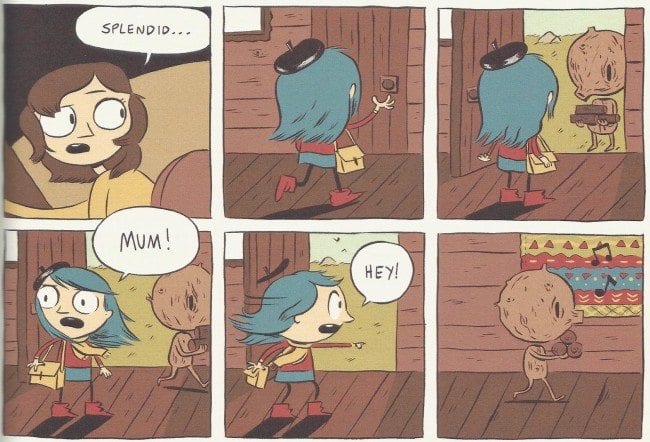
Do you do any research for the Hilda books?
Not particularly, besides reading the kind of thing I just described. If I was setting Hilda in a particular place or time then I would, but at this point I am treating her world as a purely fantasy one. A lot of it is drawn from specific folk tales and mythology but that's all been mixed in with a load of made up stuff from the start. It's also more or less set in the present day, or an alternative version of the present day, so I don't worry about period outfits or technology or anything. There are a few specific cities that I consistently reference for Trolberg but that's about it.
Which cities?
Bergen in Norway, Reykjavik and Copenhagen are maybe the main ones. The geography of Trolberg, being at the end of a fjord with mountains on either side is partially based on a place in Norway called Odda. That mostly applies to general building style and colors of the place. When I'm drawing the streets it basically ends up looking like an English town with more wooden paneling I think. Sometimes I steal real buildings for it. The elf town hall is actually a tiny version of Tamworth town hall. Trolberg library is the library in Oslo where they have OCX.

What’s your working process like? How long does it take you to put together one Hilda book?
It's been a bit different each time. There's been approximately a year between each one so I've spent most of the time between them slow cooking some kind of story idea in the background while working on other projects. I used to keep that stuff pretty much in my head and go straight to a rough, but for the last two I've typed out an informal script of sorts and produced the rough from that. Nearly every time, when it comes to doing a rough, the story ends up changing wildly from what I've been talking about for months but luckily Alex (Nobrow's creative director and editor on these books) has been super accommodating for that kind of thing. Once the rough's been approved it's usually taken me two to three months to do the finished thing, pencils, inks and colors. I'm really bad for overestimating what I'm capable of though, and a couple of times I've had to have help with flatting to get the colors done in time.
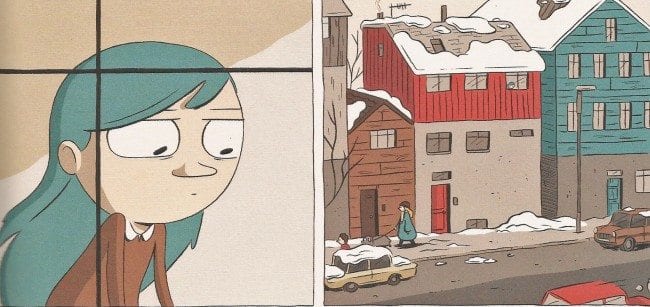
In the second Hilda book, Hilda and the Midnight Giant, you make a large and seemingly sudden shift from the country to a more urban environment. What led to that decision? I remember being taken by surprise at the time, because it seemed like the rural setting was such an important part of the book.
The wilderness setting started to pose storytelling problems once I realized it was going to be an ongoing thing. I think I get away with it in the first one because I avoid exposition and it just feels like a cartoon world, but if I was going to develop this world I was going to have to pin down exactly how their living circumstances work, where all the other humans are, is it weird that this girl seemingly has never seen another human being in her life, doesn't go to school etc. I could have designed the world so that everyone lives in self sufficient little huts, but I didn't really want her living circumstances to be read as extraordinary or strange so I felt that the move would normalize that part of her life and give greater weight to the fantasy elements. Moomin is obviously a key influence for these comics, particularly the first one, and I was definitely trying to emulate Moominvalley logic in Hildafolk which didn't really work or make sense when I started to write further.
I also set her up as being very comfortable in the original setting, like she already knew the place like the back of her hand, so I felt it would be dramatically interesting, both immediately and ongoing, to uproot her from that and throw her into unfamiliar territory. I regret that it happens so early in the series though. It would probably have been better if I'd held off a bit and let readers get more attached to the original setting. As it is I worry the change might just be annoying as it happens almost as soon as things have got started.

Many of the Hilda books thus far, especially the new one, involve creatures and characters that seem menacing or meddlesome at first but turn out to be harmless or beneficial. I was wondering how conscious you were of this theme and how it ties into your desire to have Hilda avoid violence.
I'm very conscious of it and worry about how quickly that could (has?) become trite. I suspected that people might roll their eyes and take a stab at the ending as soon as the Black Hound even appears. So I try to make the details and the unfolding of that outcome as interesting and unexpected as possible. It's definitely connected to avoiding violence but also to avoiding antagonists in general. I don't particularly want to pit a little girl against some supernatural villain who's out to get her. That would change the tone of the series completely. I have one real "bad guy" in mind that could potentially come in towards the end of the series, but really I think any true antagonist of Hilda's would just be some other kid. I'm not against depicting violence or anything and it does occur to some extent. The Nisses are pretty violent towards each other, the elves trash Hilda's house. I tried to show that the Hound is dangerous; it's not a misunderstanding or anything. I'm inclined to finish each book on a positive note because they're standalone stories and everything needs to be resolved in some way. I just don't want the resolution to ever be Hilda bashing some evil creature's head in and for that to save the day.

What sort of feedback from kids, librarians, etc., are you getting with the Hilda books? My perception is it’s becoming a popular series but that sort of thing can be difficult to gauge.
I don't know how to gauge popularity either, but I do get really good feedback. I've had a few emails from librarians saying they've been popular. Every now and then I get drawings and letters from kids, usually giving me suggestions for what should happen in the next book. The best thing is World Book Day. I don't know if they have it in the U.S., but kids go to school dressed up as a character from a book and the last three years I've had a couple of emails from parents sending me photos of their kids dressed as Hilda (there's also been one Twig and apparently a boy who went as an elf but I didn't see a picture of that one). That always makes my day.
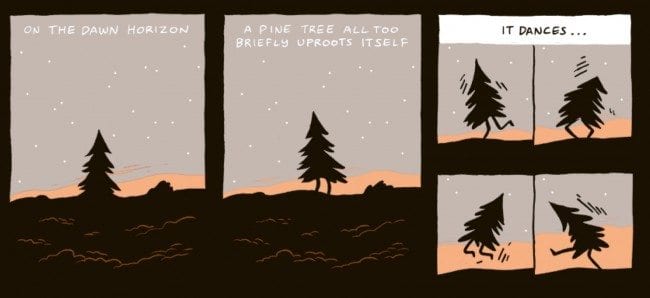
In addition to the Hilda series, you’ve done comics for adults as well. Are you concerned at all about being typecast as a “children’s author?” Are you worried now that Hilda is becoming successful that there will be pressure (self-induced or otherwise) to keep producing more of the same, that you won’t get the opportunity to work on other, more adult projects?
I was concerned about that for a long time. Doing children's work in general wasn't necessarily what I was most compelled to do when I started with Hilda. It was more like that was the comic I was best positioned to make when the opportunity came along. Ironically, the pressure I feel right now is actually to make more adult comics. When I drew Everything We Miss, that was much closer to what I saw myself doing at the time and it was probably the most pleasant and natural-feeling experience I've had drawing a comic. I always kind of thought that was my natural comics voice or something and Hilda was written and drawn in a voice and style that I developed for that particular series and while I enjoyed that, it was affected and not really any kind of personal expression. But looking back on Everything We Miss with a few years since having done much along those lines, it's clearly the most affected and self consciously "indie comics" thing I've done and it makes me cringe. I wrote it with a naive confidence and a lack of embarrassment which I've entirely lost now.
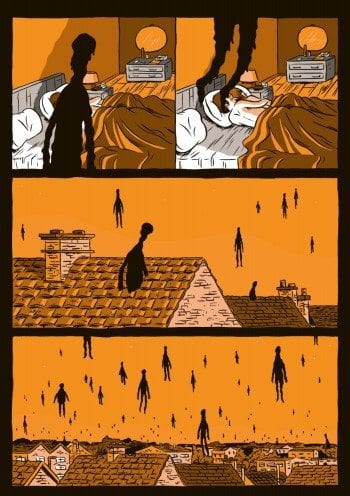
It's frustrating because I want to be able to produce work that I'd be interested in as a reader. The truth is I continuously have opportunities to do that stuff, but I second guess everything as try-hard or embarrassingly derivative and on the few occasions I've gotten over the hurdle and done something, I tend to prove myself right and it makes the next thing even harder.
The time might come when I have to give it up and accept that I'm a "children's comic book artist" but I don't think it will be connected to whether or not Hilda is successful. People sometimes ask me if Hilda's going to be "my Tintin" and the thought of that has always chilled me to the bone, but if that does end up being the case, then maybe that's fine. I don't know. I might just not have anything to bring to the larger comics world.
How did the Hilda toy come about?
It was just suggested by Nobrow as something we could do and I said yes. I had to design a thorough turnaround for her which was actually a really useful exercise as I'd never done that before and it helped tackle certain problems and vaguenesses with her design. My only regret is that it falls into expensive designer toy world and isn't pocket-money friendly, but I think that kind of has to be the case for something that isn't going to be produced on a colossal scale.
How difficult is it for you to divide your time between comics and illustration work?
It's not really too difficult at all. I'm not the kind of illustrator who is constantly on it. I don't chase down jobs and I don't have an agent. I basically do whatever comes along (provided it's not mind-numbing/really badly paid/gross/morally unsound etc) and then try to spend the rest of my time on comics or other pursuits and it seems to just about work out. If a deadline is coming up I sometimes go into lockdown and have to turn anything down outright, but usually if an illustration job comes in and it's reasonably paid I will make room for it, if it's a quick turnaround at least. I'm aware that I'm really very lucky that it's worked out as it has so far. Interest could easily drop off on either end and I'd be kind of lost.

What’s your working relationship with Nobrow like? Do they offer any sort of editorial input on your work or are they pretty much hands-off?
Alex acts as editor on the books. He'll give feedback on my roughs and a couple of times that's resulted in significant changes. For instance, I was struggling with the ending of The Bird Parade and turned something in I wasn't super happy with (but was fully intending to draw) because I was running out of time. But he recognized that the last ten pages or so weren't working and we had a bunch of discussions and two or three rewrites later it was different in a way that kind of changed the whole book and worked a lot better. Occasionally Alex will come up with some idea or plot point that I reject out of hand and then later on end up working into one of the books. But most of the time the input just involves story mechanics or the way something's worded and I think anytime I've actually disagreed I've gotten my own way. They've let me get away with quite a lot and I think at this point they pretty much trust me to do a decent job, at least with Hilda.
What are you working on now?
Other than a few illustration things, I'm actually trying to figure out a couple of comics that I'm hoping to self publish soon, as this is the first time since I started that I don't officially have a new Hilda book on the schedule. I'm going to have my first solo exhibition in Hamburg in October so I'm working on some stuff for that (though it'll mainly be originals and stuff from past projects) and I also want to have something new for Thought Bubble this year. There are tentative plans for a next "book."
